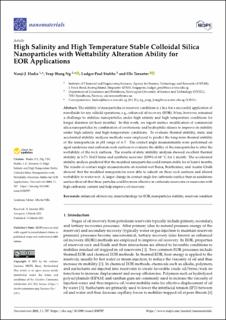| dc.contributor.author | Hadia, Nanji | |
| dc.contributor.author | Ng, Yeap Hung | |
| dc.contributor.author | Stubbs, Ludger P. | |
| dc.contributor.author | Torsæter, Ole | |
| dc.date.accessioned | 2021-03-12T12:22:37Z | |
| dc.date.available | 2021-03-12T12:22:37Z | |
| dc.date.created | 2021-03-11T15:15:25Z | |
| dc.date.issued | 2021 | |
| dc.identifier.citation | Nanomaterials. 2021, 11 (707), 1-14. | en_US |
| dc.identifier.issn | 2079-4991 | |
| dc.identifier.uri | https://hdl.handle.net/11250/2733165 | |
| dc.description.abstract | The stability of nanoparticles at reservoir conditions is a key for a successful application of nanofluids for any oilfield operations, e.g., enhanced oil recovery (EOR). It has, however, remained a challenge to stabilize nanoparticles under high salinity and high temperature conditions for longer duration (at least months). In this work, we report surface modification of commercial silica nanoparticles by combination of zwitterionic and hydrophilic silanes to improve its stability under high salinity and high temperature conditions. To evaluate thermal stability, static and accelerated stability analyses methods were employed to predict the long-term thermal stability of the nanoparticles in pH range of 4–7. The contact angle measurements were performed on aged sandstone and carbonate rock surfaces to evaluate the ability of the nanoparticles to alter the wettability of the rock surfaces. The results of static stability analysis showed excellent thermal stability in 3.5% NaCl brine and synthetic seawater (SSW) at 60 ◦C for 1 month. The accelerated stability analysis predicted that the modified nanoparticles could remain stable for at least 6 months. The results of contact angle measurements on neutral-wet Berea, Bentheimer, and Austin Chalk showed that the modified nanoparticles were able to adsorb on these rock surfaces and altered wettability to water-wet. A larger change in contact angle for carbonate surface than in sandstone surface showed that these particles could be more effective in carbonate reservoirs or reservoirs with high carbonate content and help improve oil recovery | en_US |
| dc.language.iso | eng | en_US |
| dc.publisher | MDPI | en_US |
| dc.rights | Navngivelse 4.0 Internasjonal | * |
| dc.rights.uri | http://creativecommons.org/licenses/by/4.0/deed.no | * |
| dc.title | High salinity and high temperature stable colloidal silica nanoparticles with wettability alteration ability for EOR application. | en_US |
| dc.type | Peer reviewed | en_US |
| dc.type | Journal article | en_US |
| dc.description.version | publishedVersion | en_US |
| dc.source.pagenumber | 1-14 | en_US |
| dc.source.volume | 11 | en_US |
| dc.source.journal | Nanomaterials | en_US |
| dc.source.issue | 707 | en_US |
| dc.identifier.doi | 10.3390/nano11030707 | |
| dc.identifier.cristin | 1897376 | |
| dc.relation.project | Norges forskningsråd: 262644 | en_US |
| dc.description.localcode | : © 2021 by the authors. Licensee MDPI, Basel, Switzerland. This article is an open access article distributed under the terms and conditions of the Creative Commons Attribution (CC BY) license (https:// creativecommons.org/licenses/by/ 4.0/) | en_US |
| cristin.ispublished | true | |
| cristin.fulltext | original | |
| cristin.qualitycode | 1 | |

